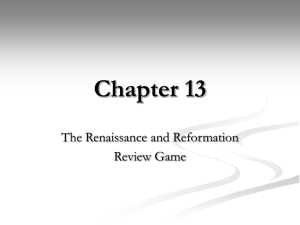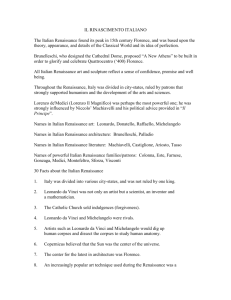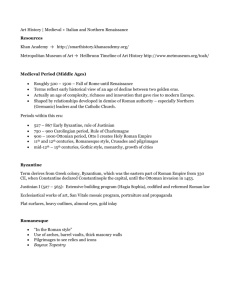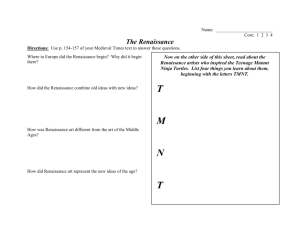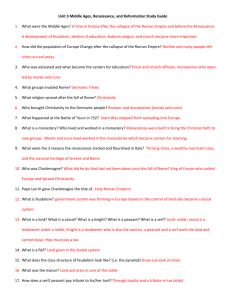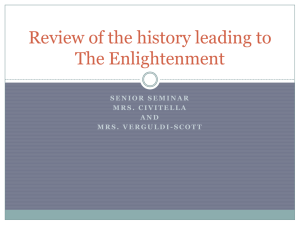Renaissance
advertisement
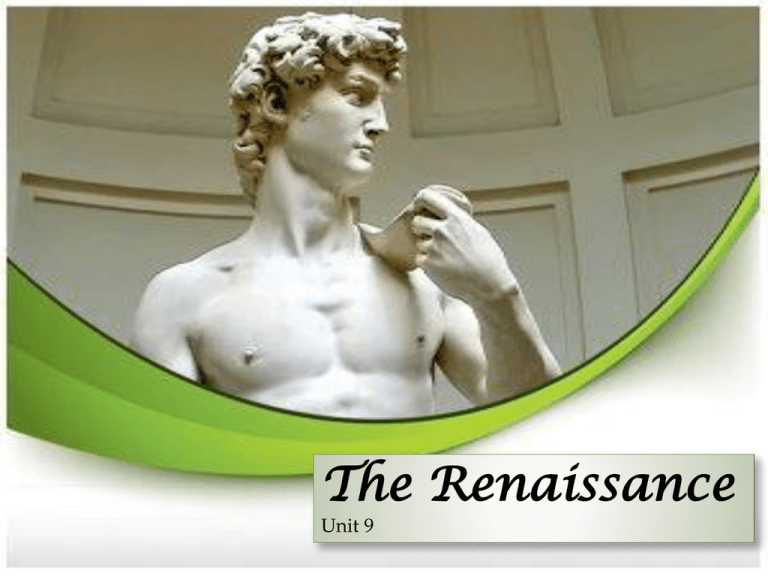
The Renaissance Unit 9 Unit 9 The Renaissance (Ch. 15 and 16.1-2) SSWH9 The student will analyze change and continuity in the Renaissance and Reformation. a. Explain the social, economic, and political changes that contributed to the rise of Florence and the ideas of Machiavelli. b. Identify artistic and scientific achievements of Leonardo da Vinci, the “Renaissance man,” and Michelangelo. c. Explain the main characteristics of humanism; include the ideas of Petrarch, Dante, and Erasmus. d. Analyze the impact of the Protestant Reformation; include the ideas of Martin Luther and John Calvin. e. Describe the Counter Reformation at the Council of Trent and the role of the Jesuits. f. Describe the English Reformation and the role of Henry VIII and Elizabeth I. g. Explain the importance of Gutenberg and the invention of the printing press. SSWWH10 The Student will analyze the impact of the age of discovery and expansion into the Americas, Africa, and Asia. a. Explain the roles of explorers and conquistadors; include Zheng He, Vasco de Gama, Christopher Columbus, Ferdinand Magellan, James Cook, and Samuel de Champlain. b. Define the Columbian Exchange and its global economic and cultural impact. c. Explain the role of improved technology in European exploration; include the astrolabe. SSWH13 The student will examine the intellectual, political, social, and economic factors that changed the world view of Europeans. a. Explain the scientific contributions of Copernicus, Galileo, Kepler, and Newton and how these ideas changed the European world view. Video: Introduction to Renaissance Early 1300s Began in Italy Renaissance –or “rebirth” A philosophical and artistic movement Renewed interest in ancient Greek and Roman literature and life • A new emphasis on the power of human reason developed • • • • • Revival of trade: 11th century Improved agriculture techniques Population increase New trade routes Improved transportation The Money Changer and his Wife * City-states * New economic elite *Oligarchies and dictatorships *Ruins of the Roman Empire a reminder of Roman glory *Contact with Byzantine civilization through Crusades and trade *Knowledge of Arab and African achievements in science and medicine *An artistic awakening *The study of classical Greek and Roman literature and life *Scholar’s search for new knowledge • Roman Empire ruins reminded Italians of ancient Roman glory • Crusades and trade—contact with the Byzantine civilization, whose scholars had preserved Greek and Roman learning. • Trade—allowed Italians to learn of Arab and African achievements in science and medicine. These and other factors helped to encourage curiosity and the search for new knowledge among Italian thinkers. Florence, Milan, Naples, Rome, and Venice had grown rich through trade and industry. Florence, Italy The city that is given the most credit for the birth of the Renaissance • Center of banking and textiles • Bankers for the papacy • Nominally a republic, but controlled by an oligarchy of bankers and merchants Niccolo Machiavelli (1469-1527) • A Florentine diplomat and historian Press • Wrote the essay, The Prince • He argued that a ruler should be concerned only with power and political success. • Today some people refer to the ruthless behavior to get ahead as “Machiavellian.” • Considered a humanist because he looked to the ancient Romans as models. • Lack of conventional morality in The Prince , however, sets him apart from other humanists of the time. Broad knowledge about many things in different fields. Deep knowledge/skill in one area. Able to link information from different areas/disciplines and create new knowledge. The Greek ideal of the “wellrounded man” was at the heart of Renaissance education. The Nature of thought during the Renaissance education important, critical approach admiration for individual achievement supporting the arts Renaissance Thought Should lead a meaningful life belief in human dignity A renaissance man or polymath is a person who is skilled in multiple fields or multiple disciplines, and who has a broad base of knowledge. Leonardo da Vinci self-portrait (1452-1519) The quintessential renaissance man— Leonardo da Vinci Press The Virgin of the Rocks Leonardo da Vinci 1483-1486 The Last Supper - da Vinci, 1498 da Vinci’s flying machine and submarine designs Michelangelo Buonorrati sculptor Self-portrait David 1504 marble ILT with most donations gets a lunch party. They need peanut butter, canned fruit, canned vegetables, canned meat, macaroni and cheese, cereal, rice, flour, cornmeal, and other canned goods. The Pieta 1499 The Sistine Chapel 15081512 Creation of Man Detail of Michelangelo’s Work


